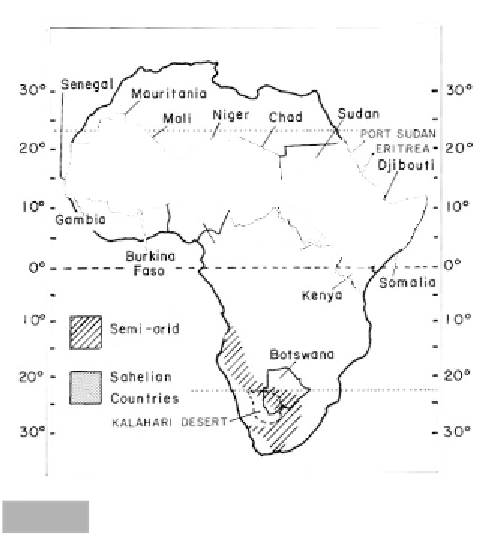Geoscience Reference
In-Depth Information
famine ensue. Requests for food from neighbors
customarily could not be refused, and relatives working
in cities were obligated to send money back to the
community or, in desperate circumstances, were
required to take in relatives from rural areas as
refugees.
A resilient social structure had built up over several
centuries before British colonial rule occurred in 1903.
Hausan farmers lived in a feudal Islamic society. Emirs
ruling over local areas were at the top of the social
'pecking order'. Drought was perceived as an aperiodic
event during which kinship and descent grouping
generally ensured that the risk from drought was dif-
fused throughout society. There was little reliance upon
a central authority, with the social structure giving
collective security against drought. Taxes were col-
lected in kind rather than cash, and varied depending
upon the condition of the people. The emir might
recycle this wealth, in the form of loans of grain, in a
local area during drought. This type of social structure
characterized many pre-colonial societies throughout
Africa and Asia. Unfortunately, colonialism made these
agrarian societies more susceptible to droughts.
After colonialism occurred in Nigeria, taxes were
collected in cash from the Hausan people. These taxes
remained fixed over time and were collected by a
centralized government rather than a local emir. The
emphasis upon cash led to cash cropping, with returns
dependent upon world commodity markets. Produc-
tion shifted from subsistence grain farming, which
directly supplied everyday food needs, to cash
cropping, which provided only cash to buy food. If
commodity prices fell on world markets, people had to
take out loans of money to buy grain during lean times.
As a result, farmers became locked into a cycle of
seasonal debt that accrued over time. This indebtedness
and economic restructuring caused the breakdown of
group and communal sharing practices. The process of
social disruption was abetted by central government
intervention in the form of food aid to avert famine.
Hausan peasant producers became increasingly vulner-
able to even small variations in rainfall. A light harvest
could signal a crisis of famine proportions, particularly if
it occurred concomitantly with declining export prices.
The Hausan peasantry now lives under the threat of
constant famine.
During drought, a predictable sequence of events
unfolds. After a poor harvest, farmers try to generate
income through laboring or craft activity. As the famine
Senegal
Mauritania
Mali
30˚
Sudan
P
ort Sudan
Eritrea
Djibouti
Niger
Chad
20˚
10˚
Gambia
Nigeria
Ethiopia
Burkina
Faso
0˚
Somalia
Kenya
10˚
Semi-arid
Botswana
20˚
Sahelian
countries
Kalahari
Desert
30˚
Map of semi-arid regions and the Sahel in Africa.
Fig. 5.1
favorable for food gathering and hunting, !Kung clans
split into progressively smaller groups with as few as
seven people. During severe droughts, however, the
!Kung gathered in groups of over 200 at two perma-
nent water holes, where they attempted to sit out the
dry conditions until the drought broke.
In societies that are more agrarian, there is a critical
reliance upon agricultural diversification to mitigate all
but the severest drought. Pre-colonial Hausa society in
northern Nigeria (on the border of the Sahara Desert)
exemplifies this well. Before 1903, Hausan farmers
rarely mono-cropped, but planted two or three differ-
ent crops in the same field. Each crop had different
requirements and tolerances to drought. This practice
minimized risk and guaranteed some food production
under almost any conditions. Water conservation
practices were also used as the need arose. If replanting
was required after an early drought, then the spacing
of plants was widened or fast-maturing cereals planted
in case the drought persisted. Hausan farmers also
planted crops suited to specific microenvironments.
Floodplains were used for rice and sorghum, inter-
fluves for tobacco or sorghum, and marginal land for
dry season irrigation and cultivation of vegetables.
Using these practices, the Hausan farmer could
respond immediately to any change in the rainfall
regime. Failing these measures, individuals could rely
upon traditional kinship ties to borrow food should
































































































































